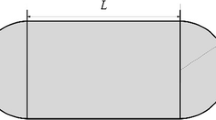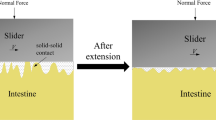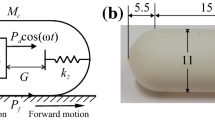Abstract
Capsule robot is the direction for future development of capsule endoscopy. The imperfection of friction model between the capsule robot and the intestine has been one of the biggest obstacles of its development. Uniform motion is the main mode of the capsule robot in the intestine. However, the frictional resistance variation of the capsule robot in this period has not been understood completely until now. This is the research content in the paper. First, some experiments are conducted to measure actual frictional resistance with a homemade experiment platform. Next, the model of the frictional resistance at a constant velocity is established based on the hyperelasticity of the intestinal material and the interactive features between the capsule robot and the intestine. At last, the theoretical result of the model is proved to be reasonable by simulation analysis. The model is efficient to describe the frictional resistance variation at a constant velocity and can be seen as another kind of stick–slip motion. The work is hoped to perfect the friction model between the capsule robot and the intestine and contribute to the development of the capsule robot.









Similar content being viewed by others
References
Geissler, N., Byrnes, T., Lauer, W., Radermacher, K., Kotzsch, S., Korb, W., Holscher, U.M.: Patient safety related to the use of medical devices: a review and investigation of the current status in the medical device industry. Biomed. Tech. Biomed. Eng. 58(1), 67–78 (2013)
Nakamura, T., Terano, A.: Capsule endoscopy: past, present, and future. J. Gastroenterol. 43(2), 93–99 (2008)
Wang, K., Wang, Z., Zhou, Y., Yan, G.: Squirm robot with full bellow skin for colonoscopy. In: Proceedings of the 2010 IEEE International Conference on Robotics and Biomimetics 2010, pp. 53–57
Quaglia, C., Buselli, E., Webster, R.J., Valdastri, P., Menciassi, A., Dario, P.: An endoscopic capsule robot: a meso-scale engineering case study. J. Micromech. Microeng. 19(10), 11 (2009)
Yang, W.A., Hu, C., Meng, M.Q.H., Dai, H.D., Chen, D.M.: A new 6D magnetic localization technique for wireless capsule endoscope based on a rectangle magnet. Chin. J. Electron. 19(2), 360–364 (2010)
Gao, M., Hu, C., Chen, Z., Zhang, H., Liu, S.: Design and fabrication of a magnetic propulsion system for self-propelled capsule endoscope. Biomed. Eng. IEEE Trans. 57(12), 2891–2902 (2010)
Wang, X.N., Meng, Q.H., Chen, X.J.: A locomotion mechanism with external magnetic guidance for active capsule endoscope. In: Engineering in Medicine and Biology Society (EMBC), 2010 Annual International Conference of the IEEE, 31 Aug 2010–4 Sept 2010, pp. 4375–4378
Kim, Y.-T., Kim, D.-E.: A novel propelling mechanism based on frictional interaction for endoscope robot. In: Advanced Tribology, pp. 859–860 (2010)
Ito, T., Ogushi, T., Hayashi, T.: Impulse-driven capsule by coil-induced magnetic field implementation. Mech. Mach. Theory 45(11), 1642–1650 (2010)
Li, H., Furuta, K., Chernousko, F.L.: Motion generation of the capsubot using internal force and static friction. In: Proceedings of the 45th IEEE Conference on Decision and Control 2006, pp. 6575–6580
Sliker, L.J., Wang, X., Schoen, J.A., Rentschler, M.E.: Micropatterned treads for in vivo robotic mobility. J. Med. Devices Trans. Asme 4(4), 8 (2010)
Terry, B.S., Lyle, A.B., Schoen, J.A., Rentschler, M.E.: Preliminary mechanical characterization of the small bowel for in vivo robotic mobility. J. Biomech. Eng. 133(9), 091010 (2011)
Hoeg, H.D., Slatkin, A.B., Burdick, J.W., Grundfest, W.S.: Biomechanical modeling of the small intestine as required for the design and operation of a robotic endoscope. In: Proceedings of IEEE International Conference on Robotics and Automation, 2000, pp. 1599–1606
Ciarletta, P., Dario, P., Tendick, F., Micera, S.: Hyperelastic model of anisotropic fiber reinforcements within intestinal walls for applications in medical robotics. Int. J. Robot. Res. 28(10), 1279–1288 (2009)
Woo, S.H., Kim, T.W., Mohy-Ud-Din, Z., Park, I.Y., Cho, J.-H.: Small intestinal model for electrically propelled capsule endoscopy. BioMed. Eng. Online 10, 108 (2011)
Kim, J.S., Sung, I.H., Kim, Y.T., Kim, D.E., Jang, Y.H.: Analytical model development for the prediction of the frictional resistance of a capsule endoscope inside an intestine. In: Proceedings of the Institution of Mechanical Engineers Part H-Journal of Engineering in Medicine 221(H8), 837–845 (2007)
Kim, J.S., Sung, I.H., Kim, Y.T., Kwon, E.Y., Kim, D.E., Jang, Y.H.: Experimental investigation of frictional and viscoelastic properties of intestine for microendoscope application. Tribol. Lett. 22(2), 143–149 (2006)
Wang, K.D., Yan, G.Z.: Research on measurement and modeling of the gastro intestine’s frictional characteristics. Meas. Sci. Technol. 20(1), 015803 (2009)
Wang, X., Meng, M.Q.H.: An experimental study of resistant properties of the small intestine for an active capsule endoscope. In: Proceedings of the Institution of Mechanical Engineers Part H-Journal of Engineering in Medicine 224(H1), 107–118 (2010)
Zhang, C., Su, G., Tan, R., Li, H.: Experimental investigation of the intestine’s friction characteristic based on “internal force-static friction” capsubot. In: IASTED International Conference on Biomedical Engineering, Innsbruck, Austria 2011. Proceedings of the 8th IASTED International Conference on Biomedical Engineering, Biomed 2011, pp. 117–123
Li, J., Huang, P., Luo, H.D.: Experimental study on friction of micro machines sliding in animal intestines. Lubr. Eng. 175(3), 119–122 (2006)
Zhang, C., Liu, H., Tan, R., Li, H.: Modeling of velocity-dependent frictional resistance of a capsule robot inside an intestine. Tribol. Lett. 47(2), 295–301 (2012)
Lyle, A.B.: Evaluation of small bowel lumen friction forces for applications in in vivo robotic capsule endoscopy. M.S., University of Colorado at Boulder (2012)
Zhang, C., Liu, H., Su, G., Tan, R., Li, H.: Research of intestines’ dynamic viscoelasticity based on five-element model. Gaojishu Tongxin/Chin. High Technol. Lett. 22(9), 964–968 (2012)
Astrom, K.J., Canudas-De-Wit, C.: Revisiting the LuGre friction model stick–slip motion and rate dependence. IEEE Control Syst. Mag. 28(6), 101–114 (2008)
Li Chun, B., Pavelescu, D.: The friction-speed relation and its influence on the critical velocity of stick–slip motion. Wear 82(3), 277–289 (1982)
Liu, Y., Pavlovskaia, E., Hendry, D., Wiercigroch, M.: Vibro-impact responses of capsule system with various friction models. Int. J. Mech. Sci. 72, 39–54 (2013)
Karagozler, M.E., Cheung, E., Kwon, J., Sitti, M.: Miniature endoscopic capsule robot using biomimetic micro-patterned adhesives. In: Proceedings of IEEE/RAS-Embs International, pp. 866–872 (2006)
Valdastri, P., Webster, R.J., Quaglia, C., Quirini, M., Menciassi, A., Dario, P.: A new mechanism for mesoscale legged locomotion in compliant tubular environments. IEEE Trans. Rob. 25(5), 1047–1057 (2009)
Acknowledgments
This work was supported by the National Natural Science Foundation of China (No. 61105099) and the National Technology R&D Program of China (No. 2012BAI14B03).
Author information
Authors and Affiliations
Corresponding author
Rights and permissions
About this article
Cite this article
Zhang, C., Liu, H. & Li, H. Modeling of Frictional Resistance of a Capsule Robot Moving in the Intestine at a Constant Velocity. Tribol Lett 53, 71–78 (2014). https://doi.org/10.1007/s11249-013-0244-5
Received:
Accepted:
Published:
Issue Date:
DOI: https://doi.org/10.1007/s11249-013-0244-5




